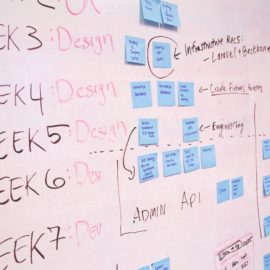

This article is an excerpt from the Shortform book guide to "Carrots and Sticks Don't Work" by Paul Marciano. Shortform has the world's best summaries and analyses of books you should be reading.
Like this article? Sign up for a free trial here .
Why is it important to set clear goals and expectations at work? What should workplace goals look like and how do you set them?
Employees don’t want to fail, and employers don’t want their employees to fail. So, the best way to set your employees up for success is to set clear expectations for their work.
In this article, we’ll discuss the importance of setting clear expectations and suggest some actionable pointers on how to approach expectation setting.
Why Are Expectations Important in the Workplace?
This should be obvious, but it often isn’t: by setting clear goals and expectations at work, you get the outcome you desire. If you don’t tell people what you want, how can you expect to get it?
A failure of an employee to perform is often a failure to communicate clear expectations with employees. As with positive feedback, managers often underestimate the clarity of goals they give to employees.
Employees don’t want to fail, and they don’t want to be yelled at. When’s the last time you purposely failed or felt good about failing? Don’t jump to this conclusion if an employee underperforms. Make sure that the goals you set were crystal clear.
Setting clear goals also allows you to evaluate people fairly. High-performing employees actually prefer clear goals, so their contributions can be distinguished from those of poor performers. “Just do your best” invites too much vagueness.
New employees need clear expectations to give them confidence they’re on the right track – think pointing a ship leaving port in the right direction. You might even make expectations clear during the interview process – what the hours are like, how they’ll be evaluated, what resources they’ll have. Doing otherwise invites dissatisfaction once they come onboard.
Good Goals
Goals should be:
- Clearly defined. Make the goals measurable. Give a sample of the expected output if possible.
- Meaningful. By knowing why a goal exists, the employee will be able to make decisions autonomously, especially in emergencies.
- Challenging but achievable. A manager’s sign read: “I expect great things from you; please expect the same from me.” If people know you see them as great, they do great things.
- Time-limited. Use deadlines to get items on a worker’s schedule, and timebox items to give clear guidelines on how much time should be spent.
- Consistent. Don’t change goals on a whim, or workers will feel their current work can be obsolete.
In the other direction, make sure you clearly understand your subordinates’ expectations.
Actionables for Expectations
Setting Goals
- Set expectations in collaboration with employees. Let them define goals they feel comfortable with – this will secure their commitment moreso than goals handed down from on high.
- Set goals far in advance, so workers know what to expect. Set high level goals over 12 months.
- Make sure that goals are measurable and include time frames.
- Clarify how employees will be evaluated. Show them a performance evaluation form.
- Explain the WHY behind expectations. This makes employees feel like partners in decision making. It also conveys the commander’s intent, empowering them to make local decisions in furtherance of the main goal.
- Give physical examples of the desired outcome. Give a sample report, or visualize the final product. In extreme cases, do the job yourself as an example. (A CEO once found his VP’s office messier than the image he wanted the organization to cultaivate. He cleaned the office himself, leaving a note that this was the cleanliness he expected.)
- Set clear expectations for new job candidates in the interview phase. Let them talk to current employees and ask questions.
- Write down goals clearly after meetings and when delegating.
- Check for understanding – ask them to describe the goal back to you clearly, live or in a followup email.
- Pull their expectations from them. Ask them to list what they believe to be their expectations, then ask them to rate themselves from 1 to 5 on how well they’re doing. Then give feedback on how closely aligned yo urea.
Managing Goals
- Help employees prioritize their work, so the important work gets the proportional amount of effort.
- Hold employees accountable for their performance goals.
- Use deadlines to allow an employee to slot in work into a schedule.
- Use checkpoints to measure progress and course correct.
- Give realtime feedback on how performance is matching expectations.
- Crayola had a nice system of giving each station a small flagpole with a green or red flag, meaning OK or behind. If all stations had a green flag, a giant green flag in the middle went up. If that giant flag was down, people knew other stations needed help.
- When employees fail, first look at your own behavior to see where you could have failed the employee. Did you communicate the goals adequately?
- Approach with the mindset of “I’m confused and I’m concerned – help me understand” to find where the information gap was.

———End of Preview———
Like what you just read? Read the rest of the world's best book summary and analysis of Paul Marciano's "Carrots and Sticks Don't Work" at Shortform .
Here's what you'll find in our full Carrots and Sticks Don't Work summary :
- How to motivate your employees and teammates to do a better job
- How to know if you're a terrible manager
- Why the carrot and stick motivation model doesn't work anymore—and what to do instead






